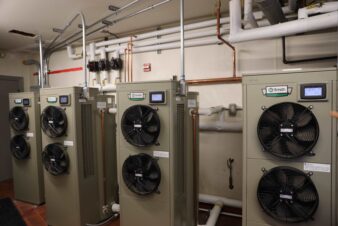Tampa, Fla. — During National Kitchen and Bath Month, the Insurance Institute for Business & Home Safety (IBHS) urges property owners to inspect interior plumbing components and complete preventive maintenance measures to reduce chances of interior water damage.
“Water damage in a kitchen or bathroom can lead to expensive repairs,” said Julie Rochman, IBHS president and CEO. “Inspecting plumbing and making any necessary repairs before small leaks become big ones will help avoid costly plumbing system failures.”
IBHS conducted a study of closed water damage insurance claims, identified five leading causes of damage, and developed the solutions featured below. 1. PLUMBING SUPPLY SYSTEM FAILURE
The average cost of a plumbing supply system failure was more than $5,000 after the insurance deductible was paid, according to the IBHS study.
Ways to Reduce Damage
Potential indicators of a plumbing problem include an increased monthly water bill, banging pipes, rust stains, moisture in the walls or on floors, and signs of wet soil erosion near the foundation.
Setting the thermostat 60 degrees or higher in winter months, letting faucets drip and insulating pipes are all ways to reduce the risk of frozen pipes.
As a backup, install a house leak detection system.
2. TOILET FAILURE
Toilet failures in the IBHS study cost more than $5,500 per incident after the deductible was paid. One-third of all toilet failures in the study resulted from an overflowing or clogged toilet.
Ways to Reduce Damage
After you flush, wait for the valve to completely finish refilling the tank and bowl. If an overflow looks imminent, turn off the supply valve.
Twice a year, inspect a toilet’s components, such as the fill, supply and flush valves and the supply line.
Consider upgrading the toilet’s supply line to a sturdier braided steel hose.
3. WATER HEATER FAILURE
The most common causes of water heater failures in the IBHS study were a slow leak or a sudden burst in the tank, followed by supply line failures.
Ways to Reduce Damage
Check the life expectancy and warranty for the water heater and replace accordingly.
Proper maintenance, such as flushing sediments and inspecting the heater’s anode rod, can increase life expectancy.
Inspect valves to ensure proper operations, and use ball valves in place of gate valves whenever possible.
4. PLUMBING DRAIN SYSTEM FAILURE
The IBHS study found more than half of plumbing system failures were the result of sewer backups. The problem was more common in southern states and on average cost $4,000 per incident after the insurance deductible was paid.
Ways to Reduce Damage
If the home’s sewer system is connected to the city’s sewer system – a particular problem for older homes – or if you are located downhill or below street level, contact a plumbing professional to install a backflow prevention assembly into the home’s sewer system.
Plant trees away from lateral drain lines to prevent roots from damaging piping.
Never pour grease down the drain.
5. WASHING MACHINE FAILURE
More than half of the claims in the IBHS study were linked to washing machine hose failures. Washing machine claims in the study averaged more than $5,300 per incident after the deductible was paid.
Ways to Reduce Damage
One burst inlet hose, and your laundry room is flooded in a matter of minutes. Replace rubber hoses every three years and consider upgrading to sturdier braided steel hoses.
When leaving the house for an extended period of time, turn off the hot and cold water supply valve to reduce failure risks.
Don’t try to cut corners by overloading the machine, and use it only while someone is at home.
Visit DisasterSafety.org for more information about how to make your buildings more resistant to a variety of disasters, big and small.




Join the conversation: